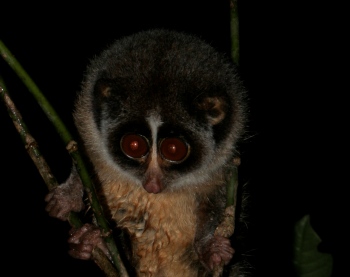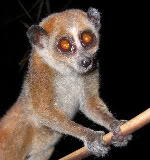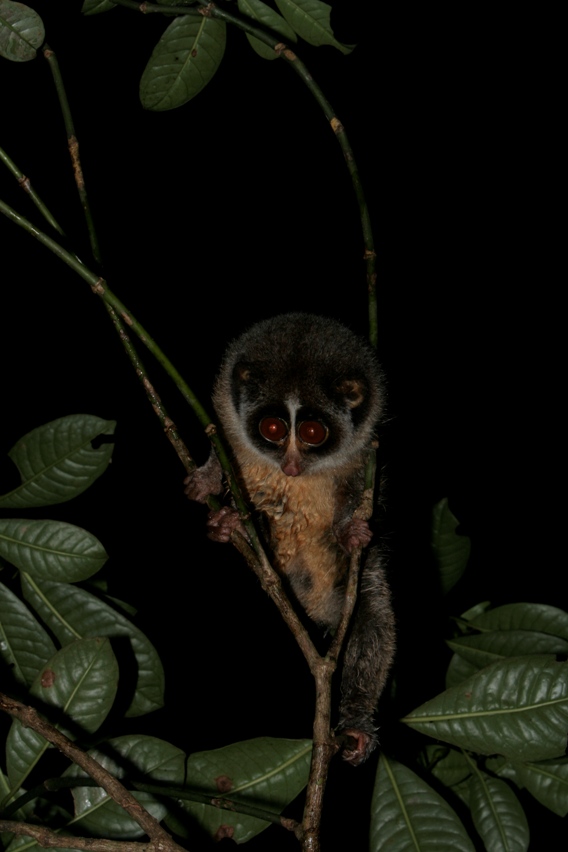The Horton Plains slender loris (Loris tardigradus nycticeboides , thought extinct by researchers for over six decades, has finally posed for a photograph. This small nocturnal primate lives in the surviving montane tropical forest of Sri Lanka. The species was photographed during a recent expedition by the Zoological Society of London (ZSL)’s EDGE program in conjunction with Sri Lankan researchers.
“The discovery improves our knowledge of this species, but we need to focus our efforts on the conservation and restoration of the remaining montane forest where this species still exists. Currently this accounts for less than one percent of the land area of Sri Lanka,” says Conservation Biologist Dr. Craig Turner from ZSL.
 First photo ever of the Horton Plains slender loris: an eight inch tall male. Full photo below. Photo courtesy of ZSL. |
A subspecies of the red slender loris (Loris tardigradus , the Horton plains slender loris is classified by the IUCN Red List as Endangered. The species is threatened by habitat loss, as well as hunting. Researchers recommend that fragmented forests need to be reconnected in order for Sri Lanka’s lorises to avoid extinction. EDGE, which is currently focusing on the species, has placed the red slender loris number 22 in terms of endangerment and evolutionary distinctness for the world’s mammals.
Given its elusive nature—the subspecies has been seen only four times since 1937—researchers spent over 200 hours searching for it.
“Nearly 1,000 nocturnal surveys have been completed in 120 different forest areas looking for all loris species to assess their status, ecological needs and current threats,” adds research leader Saman Gamage.
Researchers believe the Horton Plains slender loris has evolved shorter and tougher limbs for surviving in the montane forest climate.
“We are now conducting further studies to establish whether the Horton Plains slender loris could even be a species in its own right,” Gamage says.
Lorises are considered prosimian primates, making them more closely related to lemurs than monkeys or apes. Slender lorises are found in Sir Lanka and southern India, while the larger slow lorises are found across Southeast Asia.
Full photo of Horton Plains slender loris. Photo courtesy of: ZSL.
Related articles
Sri Lanka’s rainforests fast-disappearing but hope remains

(11/07/2006) Sri Lanka, an island off the southern-most point of India, is known as a global biodiversity hotspot for its high number of species in a relatively limited area. However this biological richness is highly threatened by one of the highest deforestation rates of primary forests in the world. In that period, the country lost more than 35 percent of its old-growth forest cover, while total forest cover was diminished by almost 18 percent. Worse, since the close of the 1990s, deforestation rates have increased by more than 25 percent. Dr Ranil Senanayake, chairman of Rainforest Rescue International, a grassroots environmental organization based in Sri Lanka, says that the key to saving the island’s last forests is to “reintroduce the concept of sustainable livelihood” to the people living in and around the island’s rainforests by establishing “commercially viable projects that explore the social and cultural relationships between people and ecology.”
YouTube videos may be imperiling cuddly primate

(02/24/2009) Many “cute” and “cuddly” species have gained attention and funds from conservation groups, since the public gravitates toward such attractive species. In fact, cuteness can sometimes mean the difference between conservation attention and extinction. However, for slow lorises being cute may be their downfall. Despite the fact that owning a slow loris as a pet or trading it is illegal in all range countries and “all countries where primates as pets are illegal,” the species is still heavily trafficked, says Dr. Anna Nekaris, an anthropologist who specializes in slow-loris research at Oxford Brookes University. During the past few years videos of pet slow lorises have begun to appear on YouTube. Such videos often include comments from users who push misinformation about the slow loris’s legality and aptitude as pets, raising concerns among conservationists that the videos encourage people to actively pursue the slow loris as a pet.
(06/11/2007) CITES delegates agreed to a total ban on trade in the slow loris, a Southeast Asian primate commonly trafficked for the pet trade. Environmental groups welcomed the move.
